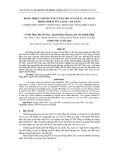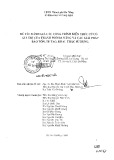
EURASIP Journal on Applied Signal Processing 2005:3, 462–470
c
2005 Hindawi Publishing Corporation
A Low-Complexity Joint Synchronization
and Detection Algorithm for Single-Band
DS-CDMA UWB Communications
Lars P. B. Christensen
Information and Mathematical Modelling, Technical University of Denmark, 2800 Kongens Lyngby, Denmark
Email: lc@imm.dtu.dk
Received 1 October 2003; Revised 2 June 2004
The problem of asynchronous direct-sequence code-division multiple-access (DS-CDMA) detection over the ultra-wideband
(UWB) multipath channel is considered. A joint synchronization, channel-estimation, and multiuser detection scheme based
on the adaptive linear minimum mean square error (LMMSE) receiver is presented and evaluated. Further, a novel nonrecursive
least-squares algorithm capable of reducing the complexity of the adaptation in the receiver while preserving the advantages of the
recursive least-squares (RLS) algorithm is presented.
Keywords and phrases: ultra-wideband, direct-sequence code-division multiple-access, multiuser detection, low-complexity
adaptive receivers, synchronization.
1. INTRODUCTION
Over the last couple of years, the interest in ultra-wideband
(UWB) wireless communications has been growing. Among
the reasons for this increased awareness of UWB are the
promises of low-power, high-bitrate wireless connections
without the need for spectrum allocation, and the approval
of the technology by authorities as, for example, the Ameri-
can FCC [1].
UWB signals for wireless communication typically have
a bandwidth of several GHz and can be utilized in many ways
each presenting the designer with tradeoffs between cost,
power, bitrate, range, and the number of users supported.
The system considered in this paper is a single-band UWB
direct-sequence code-division multiple-access (DS-CDMA)
receiver with all signal processing done on the received sig-
nal sampled directly from an amplified and filtered antenna
signal. This enables the removal of traditional up- and down-
converters present in today’s narrowband transceivers at the
expense of increasing the required sampling rate and thus the
complexity of the signal processing. It is therefore of great
interest to reduce the complexity of such receivers to make
them feasible.
The receiver considered is fully adaptive making it possi-
ble to track changes not only in the multipath channel, but
also in the received pulse shape. This is desirable in order to
maximize performance even under conditions distorting the
received pulse shape as discussed in [2], but distortions orig-
inating from the electromagnetic propagation environment
can also be adaptively compensated for.
Combined LMMSE synchronization and detection for
DS-CDMA systems have already been studied (see, e.g.,
[3,4,5,6,7]). This paper is a continuation of [8]extended
with the synchronization method in [3], but having a low-
complexity adaptive algorithm with recursive least-squares
(RLS)-speed convergence. Furthermore, this paper uses the
channel model presented in [9] instead of the model in [8]
as the latter may prove too optimistic for typical office use
as a result of the larger dimensions typically present in office
environments.
The rest of this paper is organized as follows. Section 2
describes the system model used throughout this paper. In
Section 3, the LMMSE receiver is presented as a benchmark
of how well the adaptive receiver outlined by Section 4 per-
forms compared to the best possible linear receiver. Synchro-
nization of the receiver is covered in Section 5 and Section 6
presents simulations of the receiver. Section 7 concludes the
paper with final remarks.
2. SYSTEM MODEL
The receiver considered is the adaptive LMMSE receiver
with the system model being capable of supporting Kasyn-
chronous users each operating in their respective multipath
radio channel. The desired user is, without loss of generality,
assumed to be user 1.

A Unified Low-Complexity Single-Band DS-CDMA UWB Receiver 463
2.1. Transmitted signal
The pulse shape used for transmission p(t)isofduration
Tmono and is assumed normalized to the unit energy. This
pulse shape is traditionally called a monocycle in UWB terms
and it is typically modeled as the qth derivative of a Gaussian
pulse [10], which is also the case in this paper. This makes it
possible to include the differentiation performed by the an-
tennas and further control the spectrum of the transmitted
signal. To include the effect of asynchronous operation be-
tween users, the delay τ(k)is introduced for the kth user.
Next, the binary DS spreading code c(k)(i)∈{−1, +1},
for i=1, ...,Nc, is used to separate the different users and
provide a processing gain of Nc,whereNcindicates the num-
ber of coded monocycles transmitted for each bit of infor-
mation. Finally, the binary information given by b(k)(j)∈
{−1, +1}is assumed to be a memoryless random source with
equal probability of +1 and −1. The modulation considered
is binary phase shift keying (BPSK) and the transmitted sig-
nal from the kth user can therefore be written as
s(k)(t)=
∞
j=−∞
b(k)(j)ϕ(k)t−jTb−τ(k)
=
∞
j=−∞
b(k)(j)
Nc−1
i=0
c(k)(i)pt−jTb−iTmono −τ(k).
(1)
The waveform ϕ(k)(t)hasdurationTb=NcTmono holding Nc
monocycles coded by the user’s spreading code.
2.2. Radio channel
To include the effects of a realistic multipath environment,
the radio channel model given in [9] is used. The impulse
response of this model for the kth user can be written as
h(k)(t)=
L−1
l=0
a(k)
lδt−lTch,(2)
where Tch is the temporal spacing between the Lmultipath
components and δ(t) is the Dirac delta function. The ampli-
tude of the lth multipath component is given by a(k)
land is
assumed to be constant over time. Convolving the transmit-
ted signal of the kth user given by (1) with its respective im-
pulse response given by (2), the contribution from this user
onto the received signal can be written as
r(k)(t)=
L−1
l=0
a(k)
ls(k)t−lTch(3)
and the received signal is therefore
r(t)=
K
k=1
r(k)(t)+n(t)
=
K
k=1
L−1
l=0
a(k)
ls(k)t−lTch+n(t)
(4)
with n(t) being white Gaussian noise with zero mean and
variance σ2leading to the signal-to-noise ratio (SNR) at the
receiver being defined as
SNR =L−1
l=0
a(1)
l
2
σ2.(5)
3. THELMMSERECEIVER
In the receiver an antialiasing filter processes the received sig-
nal before it is uniformly sampled and fed directly into a
tapped-delay-line filter with the input given by the vector
r(j)=rjTb,rjTb+Ts,...,rjTb+(N−1)TsT,(6)
where Nis the length of the tapped-delay-line filter with a
sample spacing of Ts. In order to be able to capture the en-
tire multipath energy spread out by the channel model, the
numberoffiltertapsmustbeatleast
Nfull =Tb+(L−1)Tch
Ts(7)
with the operator xreturning the smallest integer larger
than x. However, as the multipath energy tends to decay as
a function of the time delay, it may not be cost efficient to
capture all the multipath energy from a given bit. A reduction
in the filter length is therefore accomplished by setting
N=ψTb+(L−1)Tch
Ts,(8)
where 0 <ψ≤1 is the filter length reduction compared to
the filter that spans the entire multipath energy of a given bit.
The transmitted bits are estimated by hard decision on
the output of the filter as
b(1)(j)=sgn w(j)Tr(j)(9)
with w(j) being the column vector holding the filter coeffi-
cients.
In order to evaluate the performance of the LMMSE re-
ceiver with perfect knowledge about the channel and user
parameters, the contribution from an unmodulated bit can
seen to be
v(k)(t)=
L−1
l=0
a(k)
lϕ(k)t−lTch −τ(k)(10)
and sampling this signal produces the vector
v(k)(m)
=v(k)mTb,v(k)mTb+Ts,...,v(k)mTb+(N−1)TsT.
(11)
Although the expression of (4) includes all bits transmitted,
only a finite number of bits, L1bits before and L2bits after

464 EURASIP Journal on Applied Signal Processing
the current bit, will contribute energy to r(j). It is therefore
possible to express r(j) using only the relevant bits as
r(j)=
K
k=1
L2
m=−L1
b(k)(j+m)v(k)(m)+n(j) (12)
with n(j) holding the noise samples. The maximum bit offset
that contribute energy to r(j) is therefore
L1=(L−1)Tch
Tb(13)
as the number of bits in the past influencing the decision is
independent of ψ. On the other hand, the number of bits
after the current bit influencing the decision is
L2=ψ(L−1)Tch
Tb.(14)
The LMMSE filter coefficients wois given by the Wiener-
Hopf solution
Rwo=p⇐⇒ wo=R−1p, (15)
where Ris the covariance matrix and pthe cross-correlation
vector defined as
R=Er(j)r(j)T,
p=Eb(1)(j)r(j).(16)
Applying the expectations of (16)to(12), the covariance ma-
trix can be found to be
R=
K
k=1
L2
m=−L1
v(k)(m)v(k)(m)T+σ2I(17)
with Ibeing the identity matrix. In a similar way, the cross-
correlation vector is found to be
p=v(1)(0).(18)
The output of the filter is
wT
or(j)=
Desired
wT
ov(1)(0) +
Interference
eISI(j)+eMAI(j)+
Noise
en(j), (19)
where eISI(j), eMAI(j), and en(j) are the contributions at the
output from intersymbol interference (ISI), multiple-access
interference (MAI), and noise, respectively. Both eISI(j)and
eMAI(j) are approximately Gaussian as shown in [11]and
en(j) is Gaussian as the filter is linear. The BER of the
LMMSEreceivermaythereforebeapproximatedby
BERLMMSE =1
2erfc
wT
ov(1)(0)
2
2σ2
ISI +σ2
MAI +σ2
(20)
with σ2being the noise variance and
σ2
ISI =
m=0
wT
ov(1)(m)
2,
σ2
MAI =
K
k=2
L2
m=−L1
wT
ov(k)(m)
2.
(21)
4. THE ADAPTIVE LMMSE RECEIVER
Instead of implementing the LMMSE receiver by perform-
ing matrix inversion, the filter coefficients can be obtained
by adaptation of the filter using an appropriate training se-
quence. The normalized least mean square (NLMS) and RLS
algorithms are presented here only to give a better under-
standing of the nonrecursive formulation of the RLS algo-
rithm presented later in this section. For all algorithms, the
filter coefficients are initialized to the zero vector, that is,
w(0) =0.
4.1. The NLMS algorithm
TheNLMSupdatecanbewrittenas[12]
w(j+1)=w(j)+κ(j)r(j)e(j), (22)
where e(j) is the a posteriori error given by
e(j)=b(1)(j)−w(j)Tr(j).(23)
The variable κ(j) controls the effective step-size and is found
as
κ(j)=µ
a+r(j)Tr(j),aEr(j)Tr(j)(24)
with µbeing the step-size bound to the interval 0 <µ<2by
stability. The constant ais introduced to reduce the impact
of gradient noise when r(j)Tr(j) attains a small value. The
choice of the step-size parameter µis a tradeoffbetween con-
vergence speed, and thus the needed number of training bits,
and the residual error resulting in an increased BER com-
pared to the value of (20).
4.2. The RLS algorithm
TheRLSupdatecanbewrittenas[12]
w(j)=w(j−1) +
k(j)
Φ−1(j)r(j)ε(j) (25)
with Φ(j) being the sample covariance matrix defined by
Φ(j)=1
j
j
i=1
r(i)r(i)T(26)
and
ε(j)=b(1)(j)−w(j−1)Tr(j) (27)

A Unified Low-Complexity Single-Band DS-CDMA UWB Receiver 465
being the a priori error. In order to reduce the complexity of
the RLS update to approximately O(4N2) per bit, the follow-
ing recursion is used:
k(j)=Φ−1(j−1)r(j)
1+r(j)TΦ−1(j−1)r(j), (28)
Φ−1(j)=Φ−1(j−1) −k(j)r(j)TΦ−1(j−1).(29)
Initialization of the inverse covariance matrix is done as
Φ−1(0) =δ
Er(j)Tr(j)Iδ
r(0)Tr(0)I, (30)
where δis a regularization parameter. A value of δ1will
cause a high degree of regularization whereas δ1 will in-
troduce little regularization. The choice of δis therefore a
tradeoffbetween reducing the noise and not constraining the
adaptation.
4.3. The nonrecursive least-squares algorithm
The nonrecursive least-squares (NLS) algorithm will now be
derived from the RLS update. Let the vector γ(j)bedefined
as
γ(j)=Φ−1(j−1)r(j) (31)
and rewrite (29)as
Φ−1(j)=Φ−1(j−1) −γ(j)γ(j)T
δ(j)(32)
with the scalar δ(j) being defined as
δ(j)=1+r(j)TΦ−1(j−1)r(j)
=1+r(j)Tγ(j).(33)
Using these definitions, it is possible to rewrite the RLS up-
date as
w(j)=w(j−1) + γ(j)ε(j)
δ(j).(34)
Theideaisnowtorewrite(31) using (32) and expand the
expression all the way back to the first iteration, that is, j=1
resulting in
γ(j)=Φ−1(0)r(j)+
j−1
i=1
1
δ(i)γ(i)γ(i)Tr(j).(35)
However, instead of using the usual recursive formulation
of (35), having a complexity of O(4N2), the nonrecursive
version as directly outlined by (35) has a complexity of
O(3( j−1)N) at the jth iteration. This formulation of the
RLS algorithm takes advantage of the fact that at the jth iter-
ation, the rank of the sample covariance matrix is only j−1,
if the initialization matrix is not considered, and only j−1
inner products are therefore needed to get γ(j).
The ratio G(j) between the complexity of the RLS and
NLS algorithms at the jth iteration is approximately
G(j)4N2
3( j−1)N=4N
3( j−1) (36)
and the NLS algorithm is therefore beneficial if convergence
is reached in less than approximately 4N/3iterations.Fur-
ther, the complexity reduction averaged over the performed
iterations is 2G(Nite)withNite being the number of itera-
tions performed as the algorithm has a lower complexity in
the first iterations. Therefore, using the overall complexity as
a measure, the NLS algorithm is beneficial if convergence is
reached within approximately 8N/3iterations.
In many signal processing problems, the rank of the co-
variance matrix is full or close to being full, leading to slow
convergence of the RLS algorithm. If this is the case, the non-
recursive implementation is not preferable over the usual
recursive implementation. However, when the rank is low
compared to the dimension of the covariance matrix, a con-
siderable reduction of complexity is possible as a result of the
higher speed of convergence. An example of such a problem
is the adaptive receiver considered in this paper.
4.4. The windowed NLS algorithm
Another interesting aspect of the nonrecursive formulation
is the possibility to limit the number of summations per iter-
ation as
γ(j)=Φ−1(0)r(j)+
j−1
i=j−D
1
δ(i)γ(i)γ(i)Tr(j), i>0, (37)
where Dis the number of terms included, resulting in a com-
plexity of O(3DN) per iteration when disregarding the ini-
tialization matrix. The algorithm now performs a minimiza-
tion of the squared error over a sliding rectangular window
of size D, that is,
arg min
w(j)
j
i=j−D−1
ε(i)
2
,i>0.(38)
The algorithm is therefore termed the windowed NLS
(WNLS) algorithm. Window functions other than the rect-
angular one specified here can of course also be used if de-
sired. The algorithm can be considered a kind of a general-
ization of the NLMS and RLS algorithms as D=0equals
the NLMS algorithm and D=j−1 equals the RLS algo-
rithm. Values of Din between these two extremes provide al-
gorithms with convergence speed scaling with Das the algo-
rithm estimates the sample covariance matrix over the win-
dow. It should also be noticed that when j≤D+1, the WNLS
algorithm is equivalent to the NLS algorithm.
5. SYNCHRONIZATION OF THE ADAPTIVE
LMMSE RECEIVER
The task of synchronizing the receiver with the transmitter
and staying synchronized over time is an often-overlooked

466 EURASIP Journal on Applied Signal Processing
topic compared to modulation and demodulation. However,
as this is absolutely crucial to the performance of the sys-
tem, a method of synchronizing the adaptive LMMSE re-
ceiver is presented here based on the same principles as used
in [3].
The type of synchronization considered is the initial syn-
chronization including both bit and frame synchronization
over the UWB multipath channel in [9]. However, the prob-
lem of tracking changes between the transmitter and the
receiver is not considered. It is therefore assumed that the
clocks of the receiver and transmitter are the same except for
an unknown offset and that the channel is stationary.
5.1. Bit synchronization
Firstly, bit synchronization can be established by taking ad-
vantage of the adaptive nature of the receiver. If at first the
AWGN channel is observed, it can be noted that if the re-
ceiver is not synchronized to the transmitter, extending the
filter length by one bit length can capture all energy from a
desired bit. The adaptive algorithm will therefore automati-
cally suppress coefficients outside of the correct bit interval
and bit synchronization is therefore automatically achieved,
but this comes at the expense of increasing the filter length
to twice its original size. Increasing the filter length by a bit
length in the UWB multipath channel will, in a similar way as
in the AWGN channel, ensure that at least the same energy is
captured as if the systems were synchronous. It is then possi-
ble to estimate the timing offset between the transmitter and
receiver by observing the converged filter coefficients and use
this to correct the timing in the receiver [7]. In this manner,
the receiver will be able to take full advantage of the increased
filter length to capture a larger part of the multipath energy,
but this correction is not included in this paper.
The increase in filter length may be modeled by a larger
value of ψgiven by
ψ=ψ+ψb, (39)
where ψdetermines the filter length of the fully synchronous
system and ψbrepresents the increase needed to accommo-
date a full bit length and is given by
ψb=TmonoNc
TsNfull
=Nc
Nc+(L−1)Tch/Tmono
.(40)
The AWGN channel therefore requires ψb=1 as argued ear-
lier and in the case of the UWB multipath channel, the value
of ψbwill typically be much less than unity and the increase
in complexity will therefore be small. This is a direct conse-
quence of the fact that the energy spread in the UWB channel
is typically much larger than the bit period.
5.2. Frame synchronization
In order for the receiver to lock onto the transmitted in-
formation, the bits are arranged into a frame consisting of
Nfbits. In the beginning of the frame, a known length Nt
maximal-length sequence is inserted acting as a synchroniza-
tion burst to make the adaptation possible. The remaining
Nd=Nf−Ntbits of the frame are the information bits. How-
ever, as the receiver has no knowledge of when to look for the
synchronization sequence, this ambiguity can be modeled by
placing the start of the synchronization burst at a position Ns
unknown to the receiver.
To acquire correct synchronization, the receiver will now
have to estimate Ns. This is done by searching all possible po-
sitions of the synchronization burst and select the estimate
Ns
that leads to the smallest mean square error (MSE) averaged
over the performed iterations, that is,
arg min
Ns
Nt
j=1
b(1)(j)−w(j−1)Trj+
Ns
2.(41)
The receiver now uses the converged coefficients at the es-
timated position to detect the transmitted bits. Since the
current bit influences the observation window as long as
−L2≤es≤L1, it is not required that the synchronization
error es=Ns−
Nsbe zero in order to correctly detect a bit.
Still, having es=0 maximizes the received energy and thus
makes it desirable to minimize |es|.
6. SIMULATION AND DISCUSSION
A number of simulations have been performed to assess the
performance of the described UWB receiver in the multipath
channel specified in [9].
The used monocycle is the 7th derivative of a Gaussian
pulse with a pulse width Tmono =0.67 nanosecond, as the
spectrum of this pulse propagating in free space is a good
match for the FCC regulations [1] giving a bandwidth in the
order of 3 GHz [13].Thenumberofsamplespermonocy-
cle was set to 13 yielding Ts=51.3 picoseconds in order to
provide good rejection of aliasing at half the sample rate. It
may however be possible to reduce this high sampling rate by
taking advantage of the aliasing in the form of sub-Nyquist
sampling [8].
The system simulated consists of Ksample-asyn-
chronous users each using a length Nc=15 large-set Kasami
spreading code, making it possible for up to approximately
15 users to simultaneously use the system. The users do not
need to have knowledge about the spreading codes used in
the system, as the receiver requires only the training sequence
to adapt. All users are assumed received at the same power
level.
The channel model employs a tap spacing of Tch =2
nanoseconds with the total number of taps being L=100
[9]. This results in the number of filter coefficients being
Nfull =4056 if the entire energy spread in the channel is
to be covered. The channel impulse response is fixed dur-
ing adaptation and BER measurements, but to help average
out the stochastic nature of the channel model, simulations
are averaged over 10 different channels. The reason for us-
ing only 10 different channels is that it is computationally

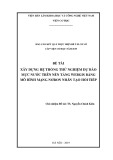
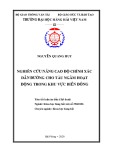
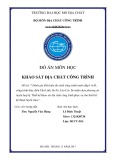
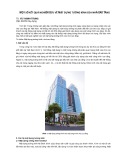
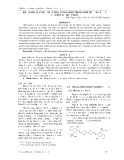
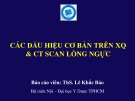
![Thuyết minh tính toán kết cấu đồ án Bê tông cốt thép 1: [Mô tả/Hướng dẫn/Chi tiết]](https://cdn.tailieu.vn/images/document/thumbnail/2016/20160531/quoccuong1992/135x160/1628195322.jpg)

